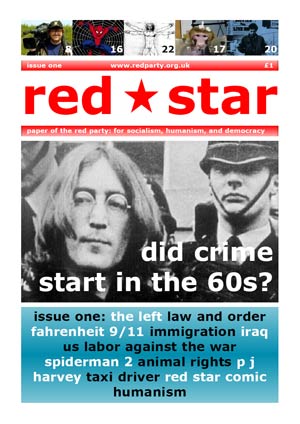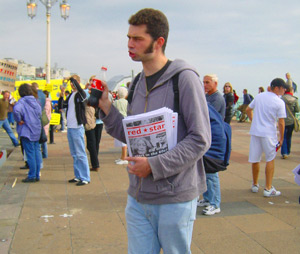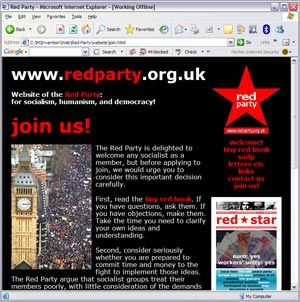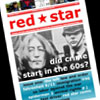 Papers: Red Star: Introduction
Papers: Red Star: Introduction Papers: Red Star: Introduction
Papers: Red Star: Introduction To this day, I cannot understand how me managed to produce the Red Star at all.
To this day, I cannot understand how me managed to produce the Red Star at all.
The Red Party consisted of only six people: David Broder, Jeremy Butler, Gerry Byrne, Rae Hancock, Darren Williams, and me. Why none of us questioned our ability to carry out our plan of printing and distributing a regular magazine I cannot now understand.
'Using your best writers' was something parties with memberships did. If you joined the Red Party, you became a political journalist, or we didn't fill an issue. And sure enough, the copy rolled in.
The surprising thing was that it was good. I thought so then, and still do. From the smallest team of writers on the British left, logic would predict the weakest paper: but as I readied their words for the first issue I blessed Saint Rosa Luxemburg (catholicism dies hard) for the comrades I was privileged to work with.
The rest of the left in general - and as we were mostly ex-members, the Communist Party of Great Britain in particular - must have been waiting for us to fall on our nose. I mean no criticism by that: but socialists are human beings too, and are as prone as the rest of the species to the evolutionary impulses of group identification and rivalry. Indeed, if I have a criticism of the left, it is not that we suffer this all too human weakness, it is that we act as if, while others may be guilty of it, we ourselves are above it.
Well, we aren't, and I was acutely conscious that our first issue would be read most keenly by those least sympathetic to us. Gerry and I got perhaps four hours sleep in the 48 spent editing and laying out the first issue by the printer's deadline.
 I'm proud of Red Star 1. To begin with, having worked to someone else's design in laying out the CPGB's Weekly Worker for so long, it was both a delight and a terror to start with an entirely blank sheet of paper. But as we sent it to the printers, I thought it looked good. And while the politics were collective, and the writing contributed by all, the design was mine. Committed democrat though I may be, I could feel myself baring my teeth at any comrade who took too close an interest in the layout.
I'm proud of Red Star 1. To begin with, having worked to someone else's design in laying out the CPGB's Weekly Worker for so long, it was both a delight and a terror to start with an entirely blank sheet of paper. But as we sent it to the printers, I thought it looked good. And while the politics were collective, and the writing contributed by all, the design was mine. Committed democrat though I may be, I could feel myself baring my teeth at any comrade who took too close an interest in the layout.
I dropped the A3 favoured by the left press for an A4 magazine format, and the rough newsprint paper for something a little cleaner and silkier. The difference in price was very small: the difference in the quality of the product enormous. The bourgeois papers are printed on large folds of newsprint because it is the only way that such a huge quantity of papers can be got out every day. The modern left does it because it is pretending that its magazines are real newspapers. It was time to move on.
Another reason for printing smaller pages was the realisation that we would reach more readers via the internet than on paper. The Weekly Worker, though it enjoyed at least ten online readers for every copy sold, nevertheless distributed PDF files of A3 pages which were simply too big to be viewed on a computer screen: and worse yet, were black and white. The printed tail was wagging the internet dog. I laid out the Red Star as a colour magazine, before reducing it to black and white for the printers. Again, it was time to stop pretending.
 But, of course, what really carried the paper was the writing, and in the days following the release of the first issue, we gradually relaxed as we received almost universal praise from possibly the most cynical of all critics: the British left. Above all, amongst the doctrinaire and jargon-ridden revolutionary titles, the Red Star was praised for being actually enjoyable to read, as if the very idea that political writing might aspire to this was rather new.
But, of course, what really carried the paper was the writing, and in the days following the release of the first issue, we gradually relaxed as we received almost universal praise from possibly the most cynical of all critics: the British left. Above all, amongst the doctrinaire and jargon-ridden revolutionary titles, the Red Star was praised for being actually enjoyable to read, as if the very idea that political writing might aspire to this was rather new.
But best of all, when the inevitable review was published in the CPGB's Weekly Worker, in 20,000 words of copy they found no political absurdity with which to crucify us. They were not happy, of course, but for want of anything they could argue with in our paper, their criticism focused on our having left the CPGB at all. It concluded "For all their ostensible non-sectarianism, their actual decision to split and set up a new party was sectarian." In its oblique way, given the state of relations between our groups at the time (in the next Weekly Worker, CPGB leader John Bridge fumed about us "the majority of them possessed no understanding of comradeship nor commitment to the norms of democratic centralism"), the absence of real criticism was implicitly the highest praise for Red Star 1 of all.
 After two issues, perhaps triggered by the strains of the political split with the CPGB, I suffered a bout of depression which forced my resignation from the group. In all, they published five issues of the Red Star, and demand for the paper grew stronger with every issue. In the end, though, the group became more informal as its comrades explored different forms of activism, from involvement with a new committee of socialist groups, a reborn Socialist Alliance, to work with anarchist groups such as Class War. The group still meet, and publish an excellent blog under the name Red Party Commando, and I should like to record here what a privelidge it was to work with them all, and how proud I remain of what we attempted, and what we achieved.
After two issues, perhaps triggered by the strains of the political split with the CPGB, I suffered a bout of depression which forced my resignation from the group. In all, they published five issues of the Red Star, and demand for the paper grew stronger with every issue. In the end, though, the group became more informal as its comrades explored different forms of activism, from involvement with a new committee of socialist groups, a reborn Socialist Alliance, to work with anarchist groups such as Class War. The group still meet, and publish an excellent blog under the name Red Party Commando, and I should like to record here what a privelidge it was to work with them all, and how proud I remain of what we attempted, and what we achieved.
The Red Star carried three of my articles, and of all my political writing, the first of these, Another bloody party, remains my all-time favourite. You can read the articles, and download the PDF's in which they appeared, by clicking the links below.
 Another Bloody Party
Another Bloody Party
Red Star 1: July 2004
 A Non-Sectarian Sect
A Non-Sectarian Sect
Red Star 2: October 2004
 Spoiling Your Ballot
Spoiling Your Ballot
Red Star 2: October 2004
 Red Star Commando (redstarcommando.blogspot.com)
Red Star Commando (redstarcommando.blogspot.com)
Successor to the Red Star, the group continues to publish this excellent political blog.
 Class War (www.classwaruk.org)
Class War (www.classwaruk.org)
Class-fighting anarchist group, and publishers of the Class War paper: one of the few publications on the left with a sense of humour.
 Socialist Alliance (www.socialistalliance.org)
Socialist Alliance (www.socialistalliance.org)
The re-formed Socialist Alliance, campaigning for the formation of a new party of the working class.